Joe Bonamassa reveals his guitar tone secrets: "What surprises me now, more than anything, is the affordability of a great sound"
In-depth insight from the blues-rock titan
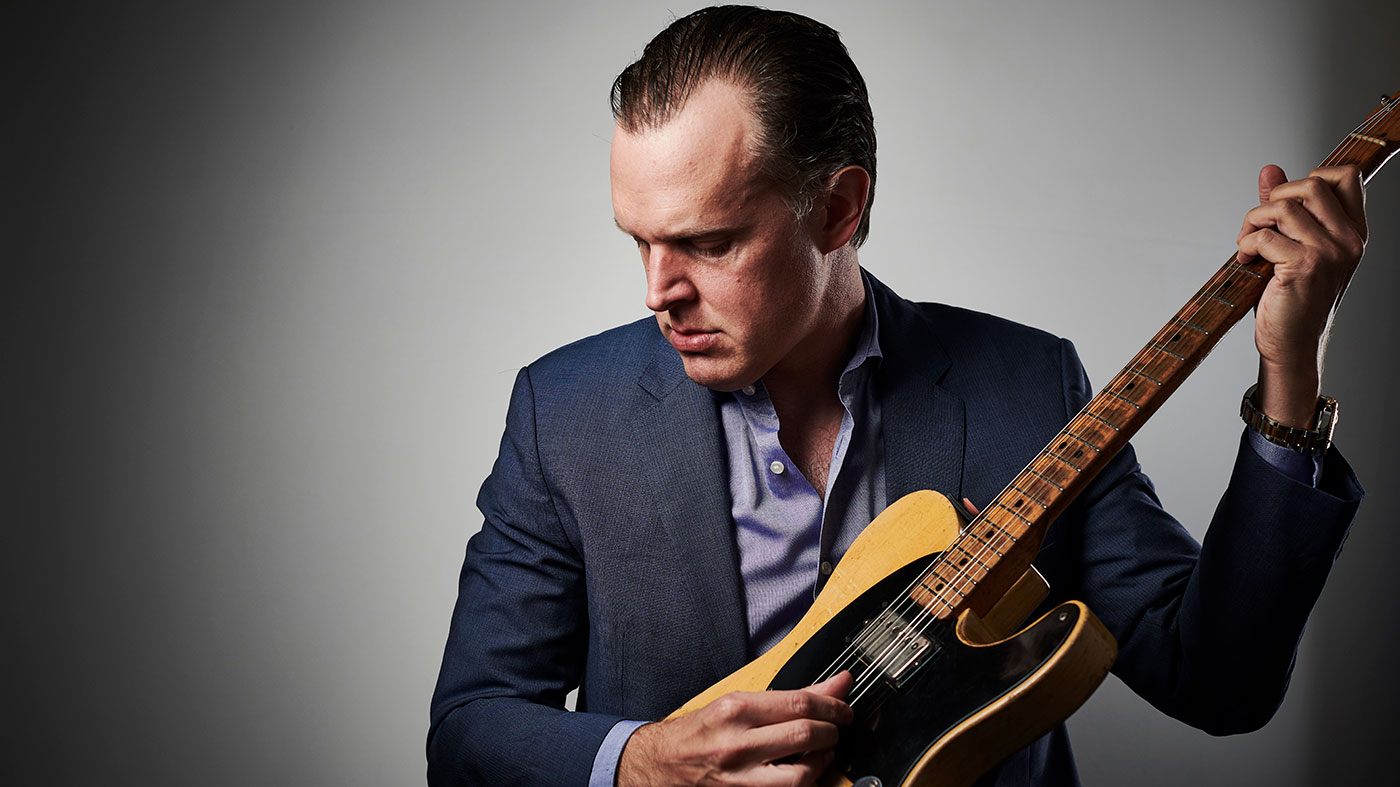
An hour or so before showtime, we join Joe Bonamassa on stage to walk around his live rig and take a look at some of the well-worn vintage hardware he’s renowned for playing, including ’bursts, Dumbles and other rarities that, to his credit, all see extensive use on the road.
While we took a look, we chat with Joe about how he sets up and uses his gear to get the most from it. Even if you don’t play blues-rock, it’s an illuminating insight into getting great live sound from a man who’s spent a lot of time experimenting in the laboratory of live sound. Here’s what he has to say…
On Dumbles and Fender Twins
“With the Dumbles, it seems like a lot of money to drag around. But they are an extension of where the Twins leave off. They do a low-mid thing that, when you hear it out the front, you go, ‘Man, that is just digging a big trench on the bottom.’
“They’re more overdriven, because I use the Overdrive section on these. If you’re just going to drive the shit out of the clean channel, you can do that with the Twins, the same thing. And then what’s the point in having them?
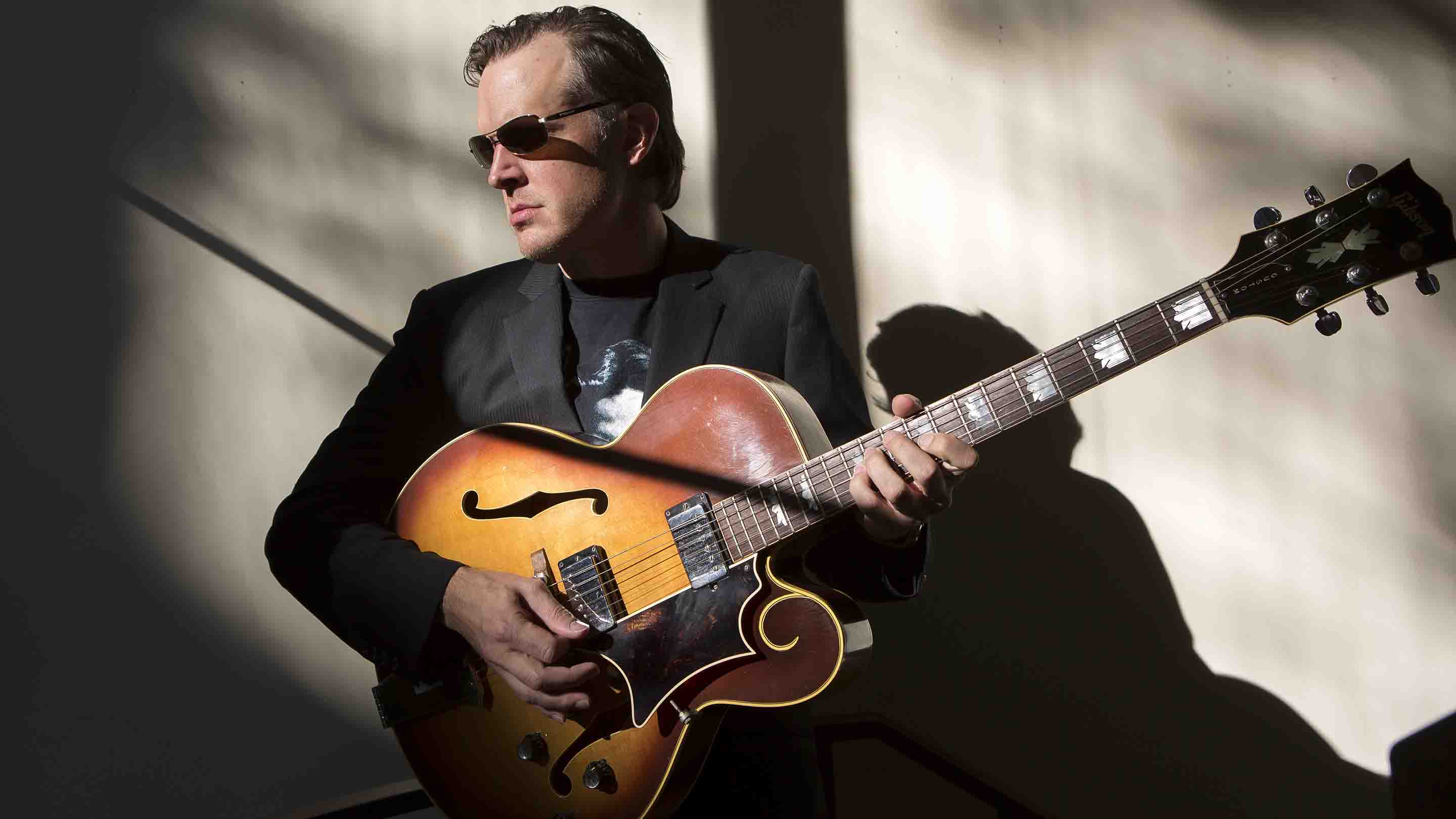
Joe Bonamassa showcases the best of his breathtaking guitar and amp collection
“So, the Overdrive, it digs a bigger trench on the bottom and it’s tighter and it’s more articulate, but it’s more saturated. So the Twins and the Dumbles do make a really nice combination. I didn’t really buy it at first. We messed around with them a little bit in the summertime on our 11-show tour. I was, like, ‘Just bring them out. It’s 11 shows and if we hate them, we can go back to the Twins.’
“But I would hear it on some of the videos that the fans would post and so I went out the front one day and just listened to the speakers. I was like, ‘Oh, man.’ The way it translated out there, man, was big and thick… It still accentuates what the particular guitar you’re playing is. Les Paul, Tele… it doesn’t homogenise their sound like some of those types of amps do. With some, no matter what you plug into it, it’s an instant Robben Ford or Larry Carlton, or those classic Dumble sounds. These 50-watters, they’re a little bit more Fender-y in their overdrive, though.
“I believe it’s probably a 50/50 blend of Fender and Dumble in the mix. Our engineer, Scott, probably tweaks that depending on the room a little. It’s 60/40 on some nights, Dumble versus Fender. If it’s a dark room, the same but Fender versus Dumble.”
Want all the hottest music and gear news, reviews, deals, features and more, direct to your inbox? Sign up here.
On getting a great overdrive sound
“I would say 90 per cent of the overdrive comes from the amps. The headroom is in the power section. The thing is, when you overdrive a high-wattage amp, when you roll the guitar back it blooms and there’s enough clean headroom; the amp has got headroom to where it’ll clean up and bloom, and bring in the overdrive gradually.
“A low-wattage amp in the bathroom will do the same thing as all this will on a big stage. A low-wattage amp, if you roll the guitar down it’ll still destroy it and still compress it. Then, by the time you’re down two or three, it’s still way too distorted. So, where I like it is when you roll the guitar down, the tone cleans up and spreads out.
“When you wail on it, it gets saturated, but it doesn’t compress, it doesn’t collapse. That’s my kryptonite. If the amp is too distorted and too compressed, I might as well just play miniature golf. I just don’t have the ability to back up the attack enough to where I find the sweet spot.”
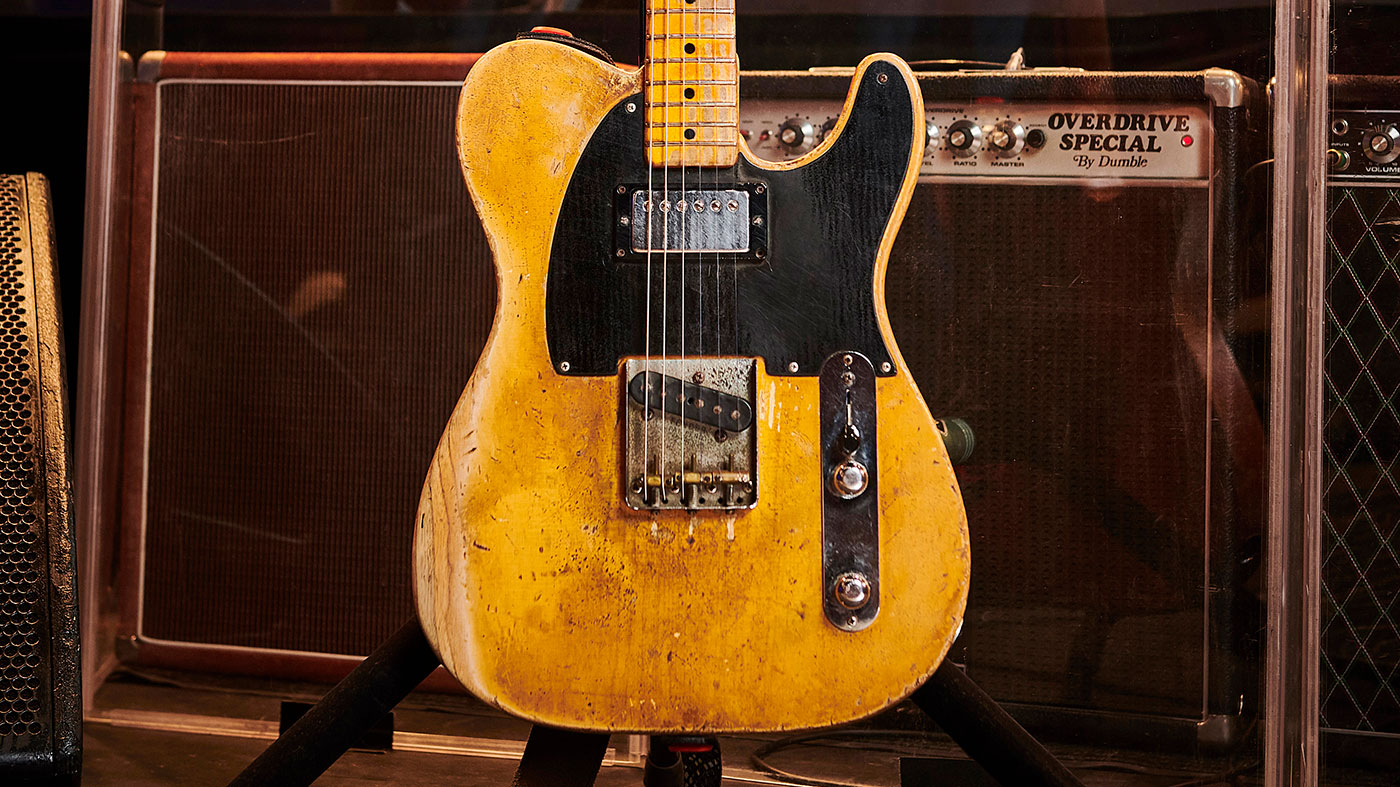
On troublesome old amps
“This Dumble in particular has been our problem child. About halfway through the set, you’ll hear it, it just starts going, ‘Wooooo…’ You either hit it on the top [of the cabinet], or you stick these towels wrapped in tinfoil on it, and it’ll stop. There’s some weirdness with that. Today, however, it’s been fine. The amp was made in 1980, so it’s almost a 40-year-old amp. That’s an old amp to begin with.
My whole career has been saturated amps with clean headroom
“If you look inside these things, this is your power amp section here. You have two [input] sockets and this section here is to make power. Next you have your EQ section here. This is the money, right here, and that’s the preamp; that’s where the overdrive comes in. This one’s not gooped, but it’s been fucked with, so it’s been worked on over the years. But I don’t know, it sounds great.”
On what Electro-Voice speakers are good for
“My whole career has been saturated amps with clean headroom. When I used the Marshalls and the Dumbles, or the Van Weeldens, whatever the old rig used to be… the way I used to get the point on the notes and the articulation was EVs. Celestions would get very squashed and very distorted and it sounded like a high-end mess of bees, so the EVs rounded that out. When you were playing the non-wound strings, it gave you a gradual transition between the wound and the unwound strings, where the high-end and the lower mids stayed the same.
“With the Fenders and the Dumbles… it solved the problem. So, the Dumble we call the ‘problem child’… I got that amp with an EV in it, and I was like, ‘This is the worst-sounding amp, in any price range, from $5 to whatever.’ But I put a Celestion in and it works. It sounds great. So, with the Twins I found Celestion works, but EV is too hi-fi, and for some reason it just doesn’t do that thing. Put the higher-wattage Celestions in all this and it’s the sweet spot. It gives you the mids and that push-pull.”
On the dangers of too much treble
“I’d rather play an evening where the guitar sounds a bit dull, than an evening where the guitar sounds a bit, ‘Holy shit… is that bright.’ Ear fatigue is a big thing about going to a guitar show. It’s like, ‘How do you make two hours seem like four?’ Well, I can show you real easy: we’ll take the baffles down and turn the gain up, and turn the brightness up.
“If you listen to BB King, it was like a human voice speaking. It was never gratey. Sometimes, with guitar, dynamically you want to go from nice smooth things to pinning them back in their seats. Sometimes, you want to just let it be.
Some people have bright hands: no matter what they play, you can roll the tone down… but it’s like an ice pick
“Some people have bright hands: no matter what they play, you can roll the tone down… but it’s like an ice pick. Where did that come from? Well, it’s the hands. Conversely, some people have no top-end in themselves, either, and you’re, like, ‘Man, they travelled all the way up and it still sounds like midrange.’ That is 100 per cent in the hands.”
On managing tone when switching guitars
“If you read out those pickups on the ’55 Strat, they’re high sixes, low sevens [in kohms DC resistance reading]. If you read out the PAFs in the ’62 ES -335, they’re high sevens, low eights. There’s not a lot of difference in the ’Bursts. The ’60 ’Burst probably is 8.2 or 8.4k. There is not a lot of difference between the output of these pickups; it’s just the difference between 250k pots or 500k pots, mahogany or maple. To me, when I have a Strat and if I want it to sound more like a Les Paul, I’m in the middle pickup. I roll the tone down a little bit and I hit the boost a little bit.”
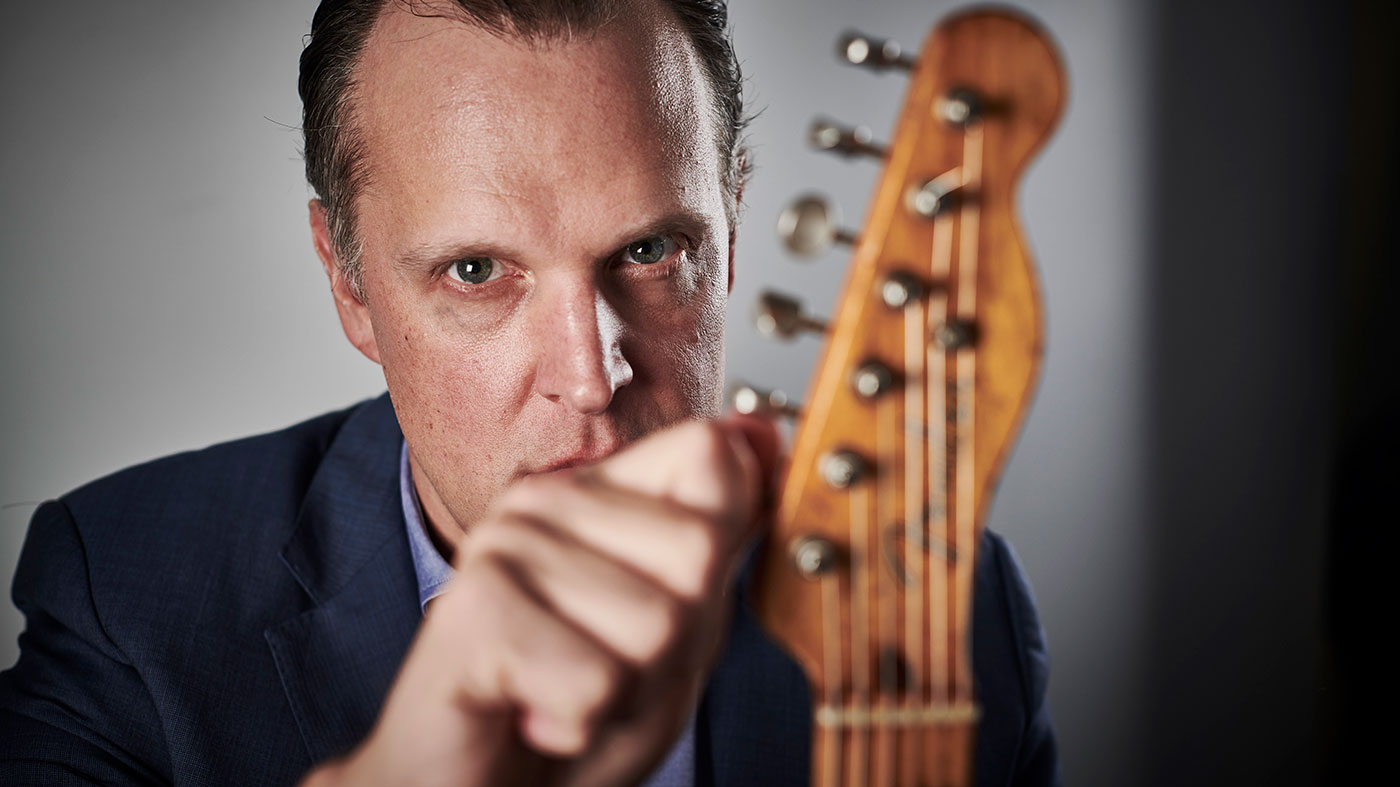
On ideal setups for Teles, Les Pauls and Strats
“I play a Tele a lot like I play a Les Paul. It’s two pickups - the two Teles I carry here are a humbucker in the front, and I play like I want to beat the shit out of it. They’re hard and they have 11s on them. You can throw something really hard at them and they come back.
The thing about Strats is they’re all different. Some Strats you put 10s on and they feel like nines
“With Strats, I tend to use 10-gauge strings, unless they’re used with an open tuning, which one or two are. The thing about Strats is they’re all different. Some Strats you put 10s on and they feel like nines. Then, you have to go up to 11s and they feel fine - I don’t know why. Some Strats you put 11s on and they feel like cables when you’re bending, but it’s the same style of fret. But I find with maple-neck Strats, 10s sound the best.
“I find that the resistance is adequate where I don’t overplay. I can dig in and I’m not over-bending, and I’m not playing out of tune. One of the things I prefer is the sound of Les Pauls and Gibsons with 10s, but with 10s I just overplay and I play out of tune. So, 11s is better, at least for up here.”
On strings
“We use 11 to 52, Ernie Balls. I know Sterling [Ball] hates it when I say it, but it’s been 11 to 52s forever. They don’t sell a set that says 11 to 52, it’s 11 to 48, but it’s close enough. At home I use the 11 to 48 Ernie Balls set, and they’re fine. Up here, you get people out front, the enthusiasm, a great seven-piece band, and then a 52 helps on the bottom. It helps just to keep the guitar in tune. So, when you strike the chords it just doesn’t go… If you video a low E string in slow motion, you’d be amazed at how much it moves.
“I’ll show you something on one of these Strats. This is a ’55. You see this wear on the neck right up by the very top of the fretboard? Do you think I’m playing it here? No. You know what that’s from? That’s from the pick and it’s from the excursion of the string when you strike it.”
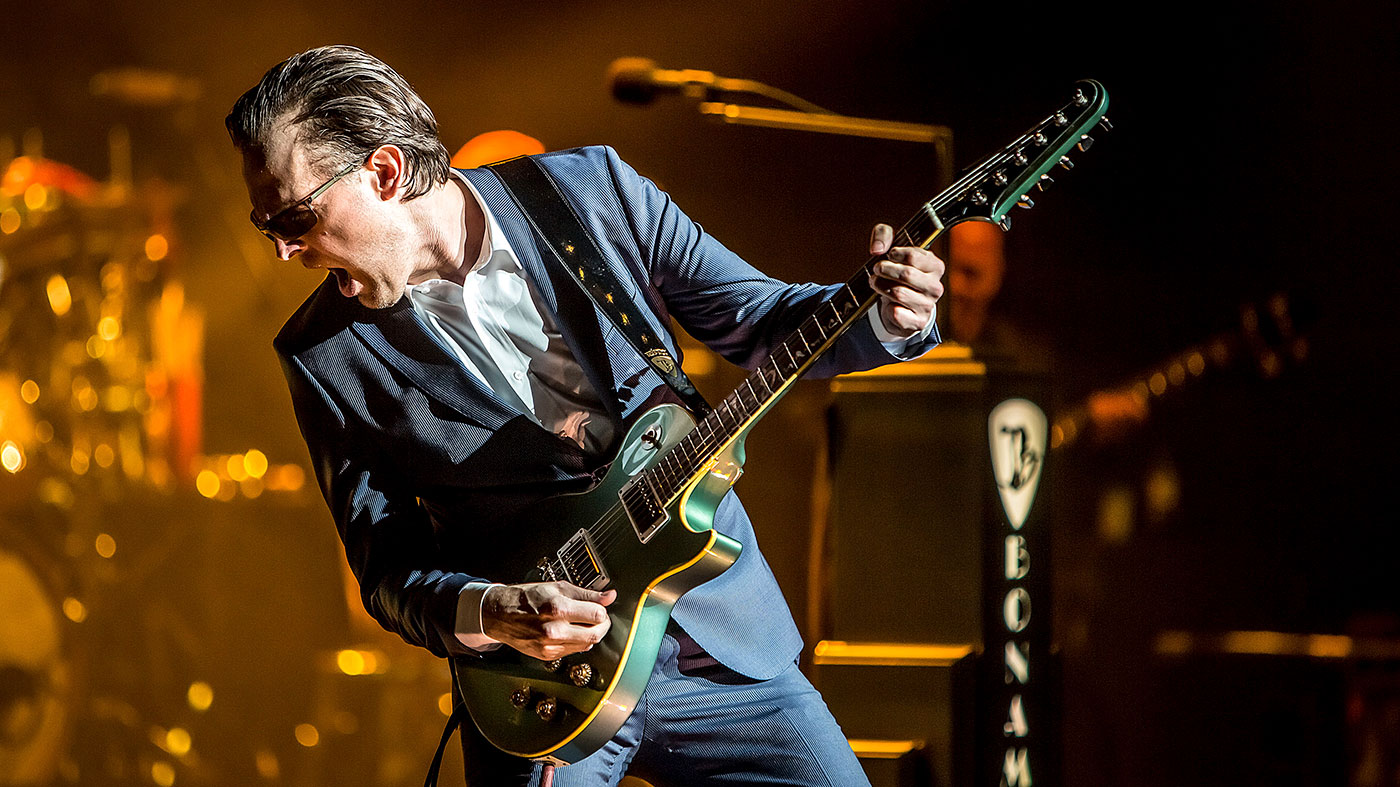
On what makes a good Les Paul
“A lot of people are scared of a skinny neck, and I’m not. I think there’s a different neck tanning on a ’60 ’burst than on the earlier ones. There’s an extra top-end and it’s a nice top-end; it’s not a crappy, ice-picky top-end. The ones that come in the latter part of ’60, from 07000 to the finale, they tend to have an extra ping to them. There’s a bit of a note and they’re bitey in all the good ways. They’re biters and not moaners.

“Some old Les Pauls tend to be very moany, some reissues are moaners, some are biters. I like a Les Paul that if you want to use it as a weapon, you have it at your disposal if I wanted to pin you against the back of your seat, as opposed to, ‘It never really gets there.’ If you have a guitar that can bite heads off, on nights that it’s a little bit too bright, then you can just roll the tone off on the guitar.”
On what makes a good Telecaster
“To sound like a fucking snob, it’s a 1955 Tele. If I could get off the train in 1955, anything flat-pole, that works for me. The Tele sounds that I grew up listening to were Roy Buchanan and the guy I took lessons from, Danny Gatton. To me, the early Jimmy Bryant stuff was on a flatpole. There is something about a flat-pole pickup; they’re different from the staggered ones.
“I don’t want to sound like a snob, but to me, it’s about the neck profile, the way the bodies felt, the way the whole thing balanced out and the amount of sounds. You know there are four sounds on a Tele, on an early Tele. There’s dead tone, front, you can wedge the switch in the middle so you get both, and then you can get the lead pickup. Or, if you have a pre-’52 Tele, the tone knob is not a tone knob, it’s a blend.
“So, if I had to get off the train it would be around 1955, with that spec. Those things, you could play the sweetest, cleanest, country Telecaster thing, or you could be as mean and as nasty without fear.
“Those flat-poles didn’t squeal as much, by far they didn’t squeal as much as things that came subsequently. Like ’56, ’57… once you get into the early 60s, ’65, ’66, it’s like, ‘Baaaaaaah.’ Even the front pickups are microphonic. Some of those late ’60 ones, they had a tone cap on where, as you rolled the volume down, they got brighter. It was gnarly.”
On why you don’t really need expensive guitars
“There’s this huge culture of boutique everything - and the notion of boutique being better than what comes out of a big maker, like a Gibson or Fender product. I mean, even Taylor and PRS are ‘The Man’ now. Where Paul [Reed Smith] used to be the Messiah for the boutique crowd, now he’s just another corporate guy - because he isn’t in his garage any more.
“You look down and these cats have got 20 pedals on their ’board, and you add up what it costs. That’s a lot of money for a tremolo pedal, and it’s a lot of money for a fuzz. You add it up and then look at some of the amps, you know… says the guy with the $100,000 Dumble [laughs]. But you start looking at those boutique amps and you go, ‘Has anybody tried an American Standard Series Strat and a Hot Rod DeVille?’ Has anybody just tried that yet?’ Man, you could rule the world with those.
“What surprises me now, more than anything, is the affordability of a great sound. If you go to get a Les Paul Studio, maybe they come out of the factory not quite set up properly, whatever… But 15 minutes on a bench, new set of strings, maybe some linseed oil - wipe it down, play it in a little bit, you know, maybe the pickups are too high, just get it to where it’s humming. That’s a great guitar for under $1,000, new or used. Plug it into a Hot Rod DeVille and you could rule the world with that.”
Jamie Dickson is Editor-in-Chief of Guitarist magazine, Britain's best-selling and longest-running monthly for guitar players. He started his career at the Daily Telegraph in London, where his first assignment was interviewing blue-eyed soul legend Robert Palmer, going on to become a full-time author on music, writing for benchmark references such as 1001 Albums You Must Hear Before You Die and Dorling Kindersley's How To Play Guitar Step By Step. He joined Guitarist in 2011 and since then it has been his privilege to interview everyone from B.B. King to St. Vincent for Guitarist's readers, while sharing insights into scores of historic guitars, from Rory Gallagher's '61 Strat to the first Martin D-28 ever made.


